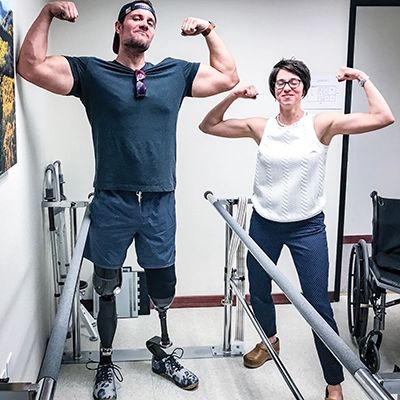Women Prosthetists Are Transforming Amputee Care
Share

Craig Towler with his prosthetist Angela Montgomery
The following blog post was developed using the article "Women Prosthetists Are Making an Impact on Amputee Care" by Larry Borowsky and the data gathering website Zippia.
In recent years, the field of orthotics and prosthetics (O&P) has witnessed a remarkable shift. Once a male-dominated profession, it is now increasingly led by women, bringing fresh perspectives and innovative approaches to patient care. This transformation is particularly significant for amputees, who are experiencing the benefits of a more diverse and empathetic workforce.
A Historical Perspective
Arlene Gillis’s journey provides a powerful lens through which to view this transformation. When she graduated in 1994, she was the only woman in the country to earn an O&P degree that year. The profession was overwhelmingly male, with men holding most leadership roles and teaching positions. Fast forward to today, and the landscape has changed dramatically. Women now make up more than 80% of students in top O&P programs, and many of these programs are led by women. The U.S. Department of Veterans Affairs prosthetic centers also reflect this shift, with numerous female leaders at the helm.
The Impact on Patient Care
Despite women representing only 25.6% of prosthetists today, their influence is reshaping the industry. As Gillis, now president of the International Institute of Orthotics and Prosthetics, notes, women often bring a more holistic approach to patient care. They tend to focus on the big picture, considering not just the biomechanical issues but also the overall well-being of the patient. This includes addressing mental and emotional health, lifestyle, and daily living activities—areas crucial for the successful integration of a prosthetic limb.
Alicia Carver, a bilateral below-knee amputee, shares her experiences as a lifelong consumer of O&P services. She emphasizes the importance of having a diverse pool of prosthetists to choose from. While she has had excellent care from male prosthetists, she finds that female practitioners often understand and address her unique needs more effectively. Issues such as clothing, skin care, and even pregnancy can be more comfortably discussed with a female prosthetist, leading to better outcomes and greater patient satisfaction.
Addressing the Gender Pay Gap
The gender pay gap remains a significant issue in the field, with women earning 85 cents for every dollar earned by men. On average, male prosthetists earn $68,040 annually, while their female counterparts earn $58,173. Addressing this disparity is crucial for ensuring that the profession continues to attract and retain talented female practitioners.
Case Studies: Real-Life Impacts
The article from Amplitude Magazine shares compelling stories that highlight the positive impact of female prosthetists. Craig Towler, a bilateral leg amputee, underscores the importance of empathy and understanding in patient care. His practitioner, Angela Montgomery, exemplifies person-centered care by deeply understanding his needs and integrating prosthetics into his life, rather than the other way around.
Kate Ketelhohn’s story further illustrates the difference a female prosthetist can make. As a teenager, she faced a disconnect with her male prosthetist over seemingly minor issues like footwear. When she switched to a clinic with female practitioners, her concerns were addressed with empathy and creativity, significantly improving her self-esteem and social integration.
A Collaborative Future
The shift towards a more balanced male-female workforce in O&P is not about replacing men with women; it’s about enriching the profession with diverse perspectives and approaches. As Gillis points out, this increased diversity fosters collaboration, moving the field forward through shared ideas and collective problem-solving. Kelley Berk, a recent O&P graduate, echoes this sentiment, highlighting that diverse approaches can coexist and complement each other, ultimately benefiting the patient.
Conclusion
At Marins Med, we recognize and celebrate the transformative impact of women prosthetists in amputee care. Their holistic, empathetic, and innovative approaches are shaping a more inclusive and effective future for the field. As we continue to innovate and create user-centric solutions for upper-limb amputees, we are inspired by the strides made by these pioneering women. Together, we can ensure that every patient receives the comprehensive, compassionate care they deserve.
For more insights and inspiring stories, visit Amplitude Magazine.
